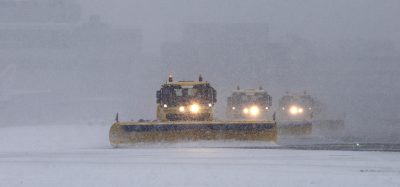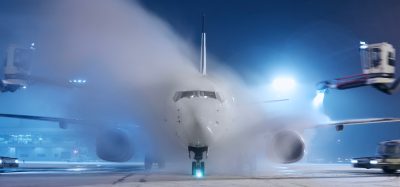Coping in the Alps
- Like
- Digg
- Del
- Tumblr
- VKontakte
- Buffer
- Love This
- Odnoklassniki
- Meneame
- Blogger
- Amazon
- Yahoo Mail
- Gmail
- AOL
- Newsvine
- HackerNews
- Evernote
- MySpace
- Mail.ru
- Viadeo
- Line
- Comments
- Yummly
- SMS
- Viber
- Telegram
- Subscribe
- Skype
- Facebook Messenger
- Kakao
- LiveJournal
- Yammer
- Edgar
- Fintel
- Mix
- Instapaper
- Copy Link
Posted: 2 October 2012 | Nicolas Karres, Head of Ramp Services at Salzburg Airport | No comments yet
Salzburg Airport is situated in the heart of Europe and is often referred to as the ‘gateway to the Alps’. Due to its location, only 4km from the city of Salzburg and close to the main skiing resorts in the area, the airport’s high season lasts from the end of December until the end of March.
A challenge every year: For Salzburg Airport, snowy and icy conditions represent an incredible logistical and organisational challenge. Salzburg usually handles an average of 3,500 to 4,000 passengers a day during the summer, autumn and spring periods. However, during the winter and specifically on Saturdays, we will handle over 30,000 passengers. Saturdays are commonly the days when hotels in the area ‘refresh’ their intake of guests, meaning that flight movements on these days are particularly busy.
The winter outlook: ‘Safety first’ is more than a slogan at Salzburg Airport, it is something that everyone who works at the airport lives up to. More than 50 employees ensure that the runway, the taxiways, the apron as well as any depository areas are free of ice and snow.
Salzburg Airport is situated in the heart of Europe and is often referred to as the ‘gateway to the Alps’. Due to its location, only 4km from the city of Salzburg and close to the main skiing resorts in the area, the airport’s high season lasts from the end of December until the end of March.
A challenge every year
For Salzburg Airport, snowy and icy conditions represent an incredible logistical and organisational challenge. Salzburg usually handles an average of 3,500 to 4,000 passengers a day during the summer, autumn and spring periods. However, during the winter and specifically on Saturdays, we will handle over 30,000 passengers. Saturdays are commonly the days when hotels in the area ‘refresh’ their intake of guests, meaning that flight movements on these days are particularly busy.
The winter outlook
‘Safety first’ is more than a slogan at Salzburg Airport, it is something that everyone who works at the airport lives up to. More than 50 employees ensure that the runway, the taxiways, the apron as well as any depository areas are free of ice and snow. Richard Moser, the Manager of Winter Services at the airport, organises the work schedule for his staff and guarantees smooth operations. From 1 November until the end of March, a weekly work schedule is introduced, involving employees from all the different departments at the airport.
Since the airport is obliged to operate between the hours of 6:00 to 23:00, it has to ensure the clearing of snow and ice to guarantee safe landings and departures.
Being well equipped
The airport has a fleet of 10 snow sweepers which consist of five Overaasen sweepers; one the RSC-200 model and four RS-400s as well as five Bucher Schörling P17s. The fleet also includes three snow ploughs, three spreaders and three Unimog vehicles as well as a Dammann spreader vehicle. This special vehicle is equipped with a Global Positioning System (GPS) facility that shows where de-icing agents have already been used ensuring that only the minimum amount of agent is utilised.
Each snow clearing team consists of a truck with an attached plough and a snow sweeper which is pulled behind. The Winter Service Manager, or one of his deputies, will be responsible for driving in front of the other teams. The Dammann spreader vehicle is designed to spray de-icing agents on the runway and can be deployed at a width of 38 metres which enables the landing strip to be de-iced within five minutes. The equipment can also be adapted to a width of 21 metres, should the clearing require a second treatment. This whole procedure guarantees the clearing of ice and snow on the runway is between five and 10 minutes. The landing strip is the first area of the airfield to be treated, followed by the taxiways and the apron.
The process
Initially, all areas are cleared from surface snow. At the same time, the snow sweepers will remove anything that the ploughs haven’t been able to extract and blow the superfluous snow to the boundaries. Snow blowers will then sweep the piles of snow into ‘green’ space along the apron and runway.
Alongside the mechanical snow removal using ploughs and snow sweepers, chemical de-icing agents are used for the operational areas, if necessary. Both the solid and liquid thawing agents are biological degradable by 99.9 per cent. An ‘early ice’ warning system which observes ground and air temperature with the help of sensitive sensors within the runway, enables an environmentally-friendly use of de-icing agents throughout the process.
The deployment of the winter service fleet depends on this early warning system as well as weather data. The Duty Officer receives the weather information online and advises the Manager of Winter Services when his services will be needed. He also passes the recently measured friction on the runway to ATC where the information is passed to the pilots who decide the feasibility of a landing at the airport.
During the hours of 23.00 and 4.00, the Commander of the Airport’s fire brigade is responsible for checking weather updates and passing on the information to the Manager of Winter Services.
Aircraft de-icing
In addition to de-icing and clearing the snow from all the operational areas, the process also involves the de-icing of aircraft. This operation requires us to begin preparations at the end of the summer season that involves two days of staff training involving theoretical knowledge and full practical drills.
Driving and operating the de-icing vehicles is obviously one of the most important parts of the ramp training programme. Before this specific training, staff will have the advantage of having worked at the airport for several years and knowing how to use most of the other equipment and vehicles. Salzburg Airport has four de-icing vehicles at its disposal, which are inspected and maintained during the summer internally and by the manufacturing company.
Since the previous winter season, we have started collecting the used de-icing fluids from the airfield, with an especially equipped vehicle that passes the liquids on to an environmentallyfriendly disposal company.
Pre-season
Before the winter season starts, de-icing fluids are checked in a laboratory to ensure that the quality of the solution is still at the required standards. The airport’s stocks are then refilled. Approximately 160,000 litres of de-icing fluids can be stored in tanks plus an additional 18,000 litres within the vehicles. Here at the airport, we are only 60km from the de-icing producing company which can guarantee a maximum emergency delivery time of 12 hours.
Running out of de-icing fluids was one of the major problems other European airports had to face during the last winter seasons. Planning in advance and negotiating good delivery conditions help us to operate continuously throughout the winter.
Well trained staff
There are 40 trained staff whose roles are to de-ice the aircraft. De-icing at Salzburg Airport always takes place at the parking position of the aircraft, as peak days do not allow taking the aircrafts to a different area.
On peak days the de-icing staff use a separate radio frequency with the codename ‘Iceman’ to enable the co-ordination of snow clearing, de-icing and instruction from air traffic control. It is important to ensure that the runway is clear before de-icing an aircraft that is due to take-off. This minimises the hold over time and prevents the airport from incurring extra costs. The pilot will then inform the ramp agent of the ground staff when he or she wants to de-ice the aircraft. We will soon be using de-icing fluids type I and II, which are used for de-icing and for anti-icing.
In addition to the 14 aircraft parking positions on the main apron, we have four positions in the general aviation centre that are used for regional aircraft on winter Saturdays. During the season staff also handle commercial wide body aircraft as well as planes that require a ‘push back’ to complete the turnaround. These aircraft are not allowed to turn by themselves and require special equipment and extra workers for the procedure.
Successful winter operations at Salzburg Airport depend on major logistical efforts involving large numbers of well trained staff. While several other European airports had to face serious problems caused by unexpected snowfalls last winter, operations at Salzburg Airport worked smoothly, independently of any weather conditions.
Salzburg Airport has received several awards for its ground handling performance. The teams are constantly prepared for the winter conditions and the ground operations managers are able meet any challenge. When other airports fear the onslaught of severe winter weather, Austrians are happy about the freshly fallen snow. Living in the Alps we not only love snow, we live it!
About the author
Nicolas Karres has been working at Salzburg Airport since 1995 where he worked as the Assistant Manager for Ground Handling Services. In 1998, he became Deputy Head of Ground Handling Services. In 2002 he was promoted to Ramp Services Manager at the Airport and is still currently working within this role.

















